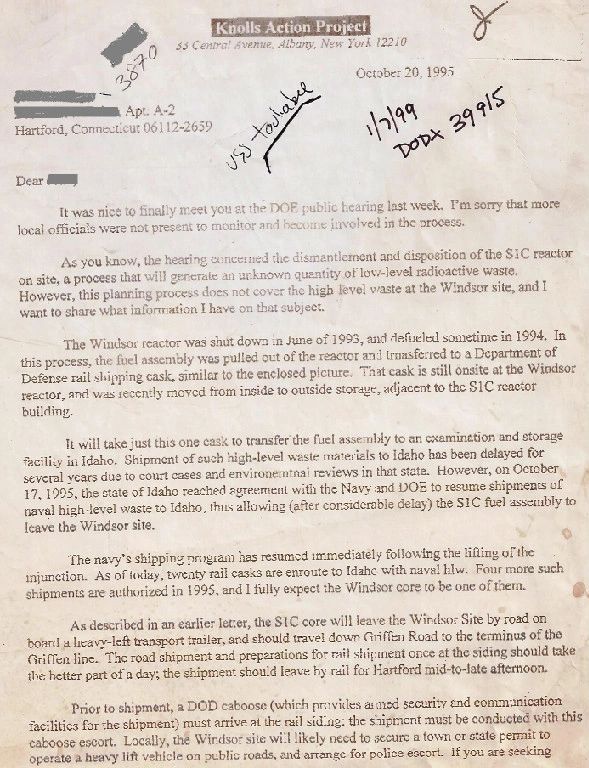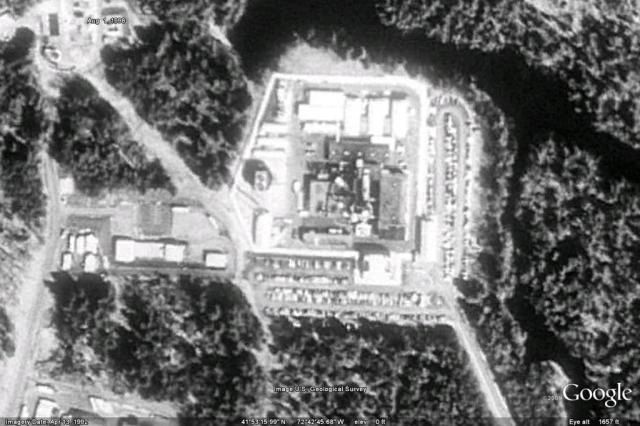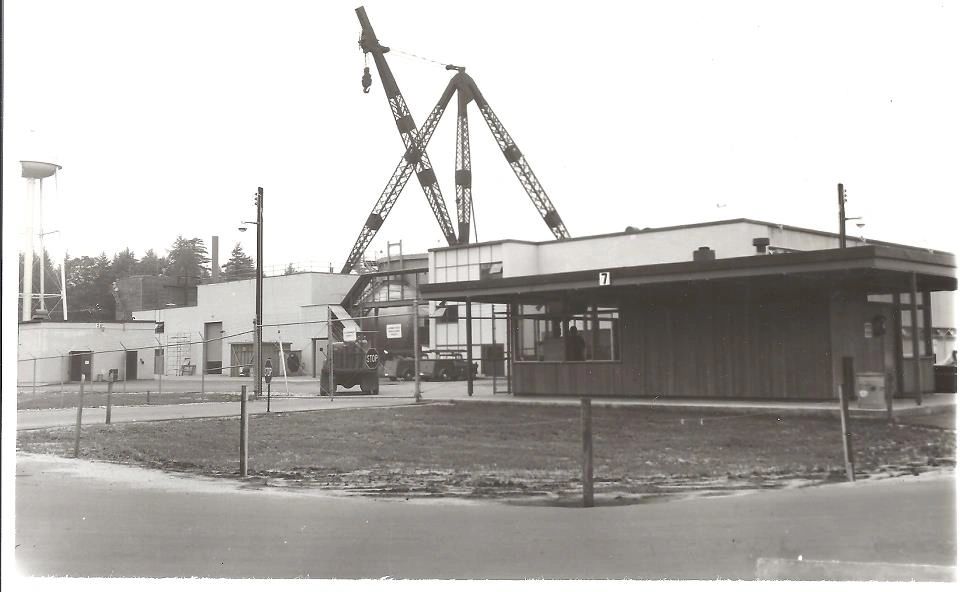Knoll Labs - Windsor
A Nuclear Reactor in The Backyard?

Most residents of Hartford County know that there are several nuclear reactors in the state. If asked, they would probably refer to the commercial reactors at Millstone Station in Waterford and perhaps the former commercial Connecticut Yankee reactor at Haddam Neck, about 20 miles south of Hartford (now decommissioned).
Yet there was another reactor, much closer to the city of Hartford that had been operating secretly for decades literally in people’s back yard. We are referring to the S1C reactor that was operated at the Knolls Atomic Power Labs in Windsor from 1959 to 1993. Knoll operated the facility, the Nuclear Power Training Unit, or NPTU, for the US Navy.
S = Submarine platform, 1= First generation code designated by the contractor, C= Combustion Engineering (C-E) was the contracted designer.
S1C, located in Windsor, CT, achieved the first self-sustaining nuclear chain reaction in Connecticut and was a prototype for the experimental USS Tullibee (SSN-597) submarine, though that boat was in fact powered by a S2C reactor. The Knoll Labs propulsion plant was unusual in that the steam turbines powered an electric motor, rather than a set of reduction gears. The electric motor was in turn connected to an electrical generator. By changing the load on the generator the load on the reactor system could be changed.
The facility consisted of naval nuclear propulsion plants, administrative offices, training facilities, an equipment service building, boiler house, and waste-handling facilities. A full scale 100% operational mock-up of the reactor and engineering spaces of a submarine served as the training platform.
Throughout the Cold War, the S1C Prototype at the Nuclear Propulsion Training Unit (NPTU) at the Windsor Site supported the submarines and surface ships of the Navy’s nuclear fleet by testing new equipment and training naval propulsion plant operators. Over 14,000 Naval operators were trained there.
The facility was initially operated by Combustion Engineering for the Department of the Navy and the Department of Energy. In 1960, the S1C site was sold to the U.S. government although CE continued to manage operations until 1970, when Knolls Atomic Power Laboratory (KAPL) took over operations. In the eighties Westinghouse would be involved.
In the mid 80s construction started on a new building that would be nick-named "Castle Gray Skull". It was of very sturdy construction with heavy rebar in the walls, massive doors and massive screens on the diesel generator air intakes to protect them from debris during hurricanes and tornadoes . The diesel generators could provide emergency power and cooling to the reactor in the event of a utility power failure. There were fully redundant systems and the generators would be on line supplying power within 30 seconds of an outage. The building was earthquake and bomb proof. There were utility tunnels connecting this building with other parts of the site. There was a large control room where plant management could go during an emergency and cots, water, food and other survival supplies were kept on hand as the building could serve as a emergency shelter. Reportedly there were large tanks of borated water contained in the building that could be used flood the reactor compartment in the event of a loss of coolant accident.
On August 28, 1985 an armed security officer employed by an outside firm committed suicide while on duty at the plant.
In the early 90s there was a security scare at the facility. A group of armed individuals came running from the woods towards the plant and showed up in the parking lot with weapons drawn. There was a tense few minutes until the plant guards sorted things out. The "intruders" were members of the Hartford Police SWAT team who were supposed to be conducting a force on force exercise at the Combustion Engineering nuclear fuel fabrication plant next door.
The reactor was shut down for the last time on March 25, 1993 and the facility eventually closed.
Full clean up of the S1C site was declared to be complete by the Connecticut Department of Environmental Protection in 2006. Remediation of the site was undertaken by Knolls Atomic Power Laboratory (KAPL), based out of Schenectady, New York.
In 2006, the site was released without any restrictions – the first-ever unrestricted radiological and chemical release of a nuclear reactor site.
Recollections of S1C:
One Navy veteran wrote:
“We next headed out to land based, operating reactors for more book learning but a lot of time spent watch standing and operating that nuclear reactor. My reactor was located in Windsor Locks Ct and was built and operated by Combustion Engineers. There was no base there and so they had us find rents in the surrounding towns. We chose Southwick, MA, got a rental on the lake and partied. They gave us all sorts of extra money because we had to pay for our rents and food, plus we were submarine qualified so we still received hazardous duty pay and by now we were mostly E-5’s [Non-commissioned Officers] and got good base pay.”
Another contributor wrote:
“I was undertaking the measurement of certain unrelated environmental factors for another branch of the US government when I realized that several of the monitoring locations I was supposed to check were on the grounds of the Knoll Atomic Power Labs. I had a pretty good idea of what KAPL was all about but felt that I had an obligation to at least check to see if they would allow me into the compound. I had experienced good luck with Combustion Engineering which was next door which was also engaged in nuclear work.
"So I locked my camera in the trunk of my car and ignoring the warning signs proceeded to drive down the long access road to the KAPL campus. As I rounded the bend the driveway opened into a parking lot which surrounded two sides of a very unusual looking industrial facility. It was lunch time and the weather was beautiful and the sight of numerous employees hanging out in the parking lot encouraged me to park my car and go inside the only entrance. As I was walking the building I had second thoughts when I saw that the fence surrounding the facility was topped with what look to me to be lethal electric fence wire! Upon entering I was greeted by two armed guards who demanded what I was doing there and whether or not I had seen the warning signs. When I explained that I was doing environmental monitoring for another government agency they called for their supervisor who promptly said that I was not welcome there and that I must leave immediately. While I was waiting for the supervisor I saw that everyone entering and leaving the facility (it was lunch time) had to go through what looked like a metal detector and that all incoming packages went through an airport style X-ray scanner."
Still another contributor commented:
"When I was stationed in Connecticut at SL-1 NPTU Windsor, there was a separate building we called Castle Greyskull which contained the emergency systems should our dinky little reactor plant (which was the back end of a Tullibee class submarine up on blocks, literally) decide to pull a mini-Chernobyl. The Castle was made out of reinforced concrete with a ventilation system that focused on recirculation with minimal contact with the outside environment. As a result, the place was radon hell, so much that our required preventive contamination surveys to ensure that nobody had carried something radioactive in there inadvertently could not even be read inside the building due to the high background radiation from the concrete. Unless the power plant was actually exploding, you were safer in the power plant hanging out right next to the reactor compartment bulkhead than you were in the supposedly safe haven of Castle Greyskull."
http://openjurist.org/765/f2d/16/united-states-v-town-of-windsor-connecticut
There is a Facebook group devoted to NPTU Windsor:
https://www.facebook.com/ctbroadcastinghistory#!/group.php?gid=41263827458

Unclassified 1987 Aerial View of the Navy's Nuclear Power Training Unit
at Knolls Labs in Windsor, CT.

This is the entrance to the site of the Knoll Atomic Power Labs in 2010.

December 1, 1995 article about the lab.







The Griffin Line railroad which extends from downtown Hartford out to northern Bloomfield was used?starting in the late fifties?to transport nuclear material to and from the nearby Knolls Atomic Power Labs in Windsor.? The line was all but abandoned for over a decade but was rebuilt in the late 90's to aid in the decommissioning of the Knoll Labs.? Highly radioactive materials from the lab, including spent fuel rods and the actual reactor core were initially transported via this line to their ultimate?disposal location in Idaho.?

1998 aerial photo.

2004 aerial photo.

2006 photo.




















